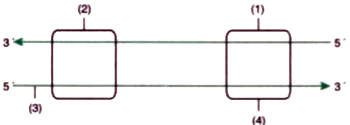The strands of DNA, which does not code for anything is referred to as :-
Template strand
Antisense strand
Coding strand
Nonocoding strand
The correct Answer is:C
To answer the question "The strands of DNA, which does not code for anything is referred to as:", we can follow these steps:
1. Understanding DNA Structure: DNA consists of two strands that are complementary to each other. One strand serves as a template for the synthesis of RNA during transcription.
2. Identifying the Coding and Non-Coding Strands:
- The strand that is used as a template for RNA synthesis is called the template strand or non-coding strand.
- The other strand, which has the same sequence as the RNA (except for thymine being replaced by uracil), is called the coding strand.
3. Terminology:
- The non-coding strand is also referred to as the anti-sense strand. This is because it is complementary to the coding strand (sense strand).
- The coding strand is often referred to as the sense strand or positive strand.
4. Conclusion: Therefore, the strands of DNA that do not code for anything are referred to as the non-coding strand or anti-sense strand.
Final Answer:
The strands of DNA that do not code for anything are referred to as the non-coding strand or anti-sense strand.
---
- The strand that is used as a template for RNA synthesis is called the template strand or non-coding strand.
- The other strand, which has the same sequence as the RNA (except for thymine being replaced by uracil), is called the coding strand.
- The non-coding strand is also referred to as the anti-sense strand. This is because it is complementary to the coding strand (sense strand).
- The coding strand is often referred to as the sense strand or positive strand.
The strands of DNA that do not code for anything are referred to as the non-coding strand or anti-sense strand.
Topper's Solved these Questions
- GENETICS & MOLECULAR BASIS OF INHERITANCE AND MUTATIONBOOK - ALLENCHAPTER - GENETICS & MOLECULAR BASIS OF INHERITANCE AND MUTATIONEXERCISE - EXERCISE-II (PREVIOUS YEAR QUESTIONS
104 Videos
- GENETICS & MOLECULAR BASIS OF INHERITANCE AND MUTATIONBOOK - ALLENCHAPTER - GENETICS & MOLECULAR BASIS OF INHERITANCE AND MUTATIONEXERCISE - EXERCISE-III (ANALYTICAL QUESTIONS
85 Videos
- GENETICS & MOLECULAR BASIS OF INHERITANCE AND MUTATIONBOOK - ALLENCHAPTER - GENETICS & MOLECULAR BASIS OF INHERITANCE AND MUTATIONEXERCISE - DEGINNERS BOX-8
5 Videos
- GENETICS BOOK - ALLENCHAPTER - GENETICS EXERCISE - Question
58 Videos
- GENETICS (PRINCIPLES OF INHERITANCE AND VARIATION) (MOLECULAR BASIS OF INHERITANCE)BOOK - ALLENCHAPTER - GENETICS (PRINCIPLES OF INHERITANCE AND VARIATION) (MOLECULAR BASIS OF INHERITANCE)EXERCISE - Question
53 Videos
Similar Questions
Assertion :- The DNA strand which does not code for anything is referred to as coding strand.
Reason :- Coding strand sequence are same as RNA and this strand contain uracil at the place of thymine.
View SolutionAssertion :- The DNA strand which does not code for nothing is referred to as coding stand.
Reason : Coding strand sequence are same as RNA except thymine at the place of uracil.
View SolutionThe strand of DNA which is complimentary to the template strand is
View SolutionAntiparallel strands in DNA is due to
View SolutionAssertion :- Both the strands of DNA are not copied during transcription.
Reason : Both strands of DNA show antiparallel polarity.
View SolutionAre the two strands of DNA molecule identical?
View SolutionThe two strands of DNA are held together by bond:
View SolutionThe enzyme which helps to cut one strand of DNA duplex to release tension of coiling of two strands is
View SolutionThe two strands of DNA are not identical, but are complementary'. Explain this statement.
View SolutionIn the following diagram the two DNA strands represented are ready for transcription.
Which one of the two strands of DNA has nucleotide sequence similar to mRNA that will be transcribed and why?

View Solution
